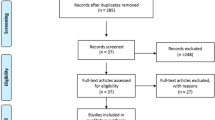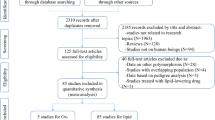Abstract
Background
A growing number of studies have suggested that the single nucleotide polymorphism (SNP) rs662 (G>A) in paraoxonase 1 (PON1) is significantly associated with susceptibility to coronary heart disease (CHD) in the Chinese population. To further evaluate the effects of the PON1 RS662 (G>A) polymorphism on the risk of CHD, we performed a meta-analysis in a Chinese population.
Methods
PubMed, Embase, Wanfang Data, Chinese National Knowledge Infrastructure (CNKI) were searched to identify eligible studies. Pooled odds ratios (ORs) and 95% confidence intervals (CIs) were used to evaluate the strength of the associations between RS662 (G>A) and CHD.
Result
In the meta-analysis, we identified 14 articles, including a total of 4835 CHD patients and 5111 controls in the Chinese population. Our result showed that overall rs662 (G>A) was significantly associated with susceptibility to CHD in the Chinese population when compared with healthy controls. Furthermore, a G allele suggested an elevated risk of CHD. In the subgroup analyses stratified by ethnicity and geographic areas, significant associations were found in Chinese Han and South China, but not in North China.
Conclusion
The present meta-analysis suggests that rs662 (G>A) SNP in PON1 is associated with CHD risk; the G allele might be the risk allele for CHD susceptibility in the Chinese population. However, more research is required to make a definite conclusion.
Zusammenfassung
Hintergrund
Immer mehr Studien liefern Belege, dass der Einzelnukleotidpolymorphismus („single nucleotide polymorphism“ [SNP]) rs662 (G>A) in der Paraoxonase 1 (PON1) signifikant mit der Anfälligkeit für die koronare Herzkrankheit (KHK) in der chinesischen Bevölkerung assoziiert ist. Zur genaueren Untersuchung der Effekte des PON1-rs662-(G>A)-Polymorphismus auf das KHK-Risiko wurde eine Metaanalyse mit chinesischen Populationen durchgeführt.
Methoden
PubMed, Embase, Wanfang Data und Chinese National Knowledge Infrastructure (CNKI) wurden nach relevanten Studien durchsucht. Mit gepoolten Odds Ratios (OR) und 95 %-Konfidenzintervallen (KI) wurde die Stärke der Assoziationen zwischen RS662 (G>A) und KHK untersucht.
Ergebnisse
In der Metaanalyse wurden 14 Beiträge mit insgesamt 4835 KHK-Patienten und 5111 Kontrollen aus der chinesischen Bevölkerung identifiziert. Die Analyse ergab im Vergleich mit gesunden Kontrollen, dass rs662 (G>A) insgesamt signifikant mit der KHK-Anfälligkeit in der chinesischen Bevölkerung assoziiert war. Darüber hinaus wies ein G‑Allel auf ein erhöhtes KHK-Risiko hin. In der Subgruppenanalyse mit Stratifizierung nach ethnischer Zugehörigkeit und geografischer Region wurden signifikante Assoziationen bei Han-Chinesen gefunden, ebenso in Südchina, nicht jedoch in Nordchina.
Schlussfolgerung
Gemäß der vorliegenden Metaanalyse ist der rs662-(G>A)-SNP in PON1 mit dem KHK-Risiko assoziiert; das G‑Allel könnte das Risikoallel für KHK-Anfälligkeit in der chinesischen Bevölkerung sein. Eine endgültige Beurteilung setzt allerdings weitere Forschungsbemühungen voraus.






Similar content being viewed by others
Abbreviations
- CHD:
-
Coronary heart disease
- CI:
-
Confidence intervals
- CNKI:
-
China National Knowledge Infrastructure
- HWE:
-
Hardy–Weinberg equilibrium
- ORs:
-
Pooled odds ratios
- PON1:
-
Paraoxonase 1
- SNP:
-
Single nucleotide polymorphism
References
Newton JN, Briggs AD, Murray CJ et al (2015) Changes in health in England, with analysis by English regions and areas of deprivation, 1990–2013: a systematic analysis for the Global Burden of Disease Study 2013. Lancet 386:2257–2274
Hu C, Kong L, Gao R (2012) Cardiovascular disease in China. China encyclopedia press, Beijing
Brass LM, Isaacsohn JL, Merikangas KR et al (1992) A study of twins and stroke. Stroke 23:221–223
Rissanen A, Nikkila E (1984) Identification of the high risk groups in familial coronary heart disease. Atherosclerosis 53:37–46
Collins FS, Brooks LD, Chakravarti A (1998) A DNA polymorphism discovery resource for research on human genetic variation. Genome Res 12:1229–1231
Wang X, Fan Z, Huang J et al (2003) Extensive association analysis between polymorphisms of PON gene cluster with coronary heart disease in Chinese Han population. Arterioscler Thromb Vasc Biol 23(2):328–334
Su S, Chen J, Huang J et al (2005) Paraoxonase gene cluster variants associated with coronary artery disease in Chinese Han women. Chin Med J 114:1167–1174 (article in Chinese)
Xie C, Ding X, Gao J et al (2014) The effects of CES1A2 A (–816) C and CYP2C19 loss-of function polymorphisms on clopidogrel response variability among Chinese patients with coronary heart disease. Pharmacogenet Genomics 24(4):204–210
Zhu J, Gong Y, Pan M, Cui Z, Yuan J (2005) The paraoxonase 1 Gln/Arg 192 polymorphism in patients with coronary heart disease. Journal of Nantong University (Medical Sciences) 25(1):15–19 (article in Chinese)
Liu T, Zhang X, Zhang J et al (2014) Association between PON1 rs662 polymorphism and coronary artery disease. Eur J Clin Nutr 68:1029–1035
Yang Y, Xia Y, Cui D et al (2007) Study on the relationship among the codon 55, 192 gene polymorphisms of paraoxonase-1 and coronary disease as well as its severity of stenosis. J Clin Cardio 23(8):566–569 (article in Chinese)
Zhai Z, Xing X, Qin H et al (2010) A study on PON1 gene polymorphism and the association of pon1 polymorphism with coronary heart disease among chinese han population of shandong weifang district. China Prac Med 5(19):25–27 (article in Chinese)
Du J, Zhang X (2013) Polymorphism of paraoxonase gene in Xinjiang Uygurs and Hans of Cerebral ischemic stroke and Coronary Heart Disease. J Xinjiang Med Fre 33:43–48
Wang M, Lang X, Zou L et al (2011) Four genetic polymorphisms of paraoxonase gene and risk of coronary heart disease: a meta-analysis based on 88 case-control studies. Atherosclerosis 214(2):377–385
Kang YH, Lao HY, Wu H et al (2013) Association of PON1 genotype and haplotype with susceptibility to coronary artery disease and clinical outcomes in dual antiplatelet-treated Han Chinese patients. Eur J Clin Pharmacol 69:1511–1519
Kang YH, Lao HY, Wu H et al (2006) Paraoxonase 1 gene Q192R polymorphism affects stroke and myocardial infarction risk. Clin Biochem 39:191–195
Han Y, Dorajoo R, Ke T et al (2015) Interaction effects between Paraoxonase 1 variants and cigarette smoking on risk of coronary heart disease in a Singaporean Chinese population. Atherosclerosis 240:40–45
Chen W, Fan X, Gao R et al (2012) Cardiovascular disease report in China [M]. Beijing: China encyclopedia press
Mazzali G, Fantin F, Zoico E et al (2015) Heart fat infiltration in subjects with and without coronary artery disease. J Clin Endocrinol Metab 100(9):3364–3371
Meeuwsen JAL, Wesseling M, Hoefer IE et al (2017) Prognostic value of circulating inflammatory cells in patients with stable and acute coronary artery disease. Front Cardiovasc Med 4:44
Steinberg D, Witztum JL et al (2010) Oxidized low-density lipoprotein and atherosclerosis. Arterioscler Thromb Vasc Biol 30(12):2311–2316
Aviram M, Rosenblat M, Bisgaier CL et al (1998) Paraoxonase inhibits highdensity lipoprotein oxidation and preserves its functions. A possible peroxidative role for paraoxonase. J Clin Invest 101:1581–1590
Acknowledgements
We gratefully acknowledge the Yichang Key Laboratory of ischemic cardiovascular and cerebrovascular disease translational medicine foundation (2017KXN09) for generous financial support.
Author information
Authors and Affiliations
Corresponding author
Ethics declarations
Conflict of interest
Z. Deng, H. Xiang and W. Gao declare that they have no competing interests.
This article does not contain any studies with human participants or animals performed by any of the authors.
Rights and permissions
About this article
Cite this article
Deng, Z., Xiang, H. & Gao, W. Significant association between paraoxonase 1 rs662 polymorphism and coronary heart disease. Herz 45, 347–355 (2020). https://doi.org/10.1007/s00059-018-4737-8
Received:
Revised:
Accepted:
Published:
Issue Date:
DOI: https://doi.org/10.1007/s00059-018-4737-8




